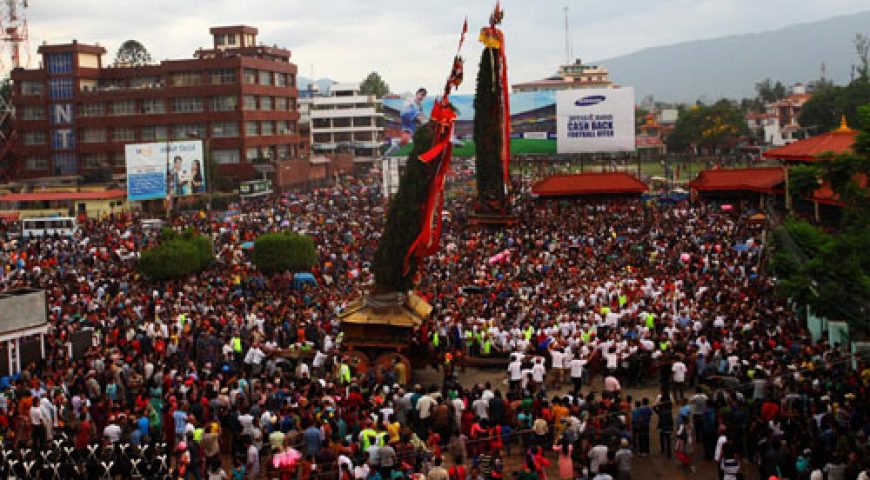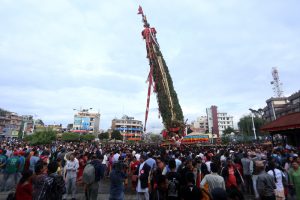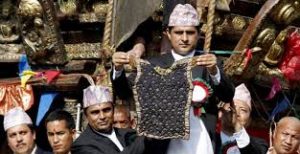
Rato Machindranath Jatra
Rato Machindranath Jatra is a chariot procession honoring the Buddhist deity of compassion Avalokiteśvara held in Lalitpur, Nepal. It is one of the greatest religious events in the city and the longest chariot festival celebrated in the country.
Rato Machhindanath Jatra is the longest running chariot festival in Nepal. Held in Patan, the festival is dedicated to the valley’s rain god. A special chariot is made out of bamboo and wood and the idol of the god is placed inside the chariot. Devotees pull the chariot to different localities in Patan. The festival ends with Bhoto Jatra, a ceremony where the rain god’s bejeweled vest is displayed.
Rato Machindranath Jatra, one of the most famous festivals in Nepal is a chariot procession type of festival which was instituted to celebrate the end of a devastating drought during the rule of King Narendra Deva (640-683 A.D).
A chariot with an approx. height of 60 feet is constructed at Pulchowk to mark the beginning of the festival.When the chariot is complete, the image of Rato Machindranath(god of rain) from his temple is installed in it. Another smaller chariot also accompanies Rato machindranath which is known as ‘Mimnath’. Revellers then drag the chariots through the streets of Lalitpur from Natole, Gabahal, Mangal Bazaar, Sundhara, Lagankhel, Kumaripati then finally rest at Jawalakhel. Bhoto jatra is celebrated some days after the chariot reaches Jawalakhel. After the festival is over, the chariot is dismantled and Rato Machindranath is taken to a temple in Bungamati.
However, every 12 years the Rato Machindranath Jatra is a bit different as the procession starts from Bungamati and ends at Bungamati. This year, 2015 marked the year for the 12-year cycle and the Rato Machindranath Jatra started from Bungamati and will end at Bungamati. Due to the earthquake in Baisakh(April), the festival had to be shifted and was finally celebrated in Ashoj(October). Since the festival was celebrated late, the Rato Machindranath only stayed for 3 days in Jawalakhel and was rushed to Bungmati after Bhoto Jatra as the festival was about to collide with the celebration of Dashain(the biggest festival in Nepal).
“This festival starts every year at the end of Baishakh [i.e., during the first half of May] depending on the auspicious date calculated by the priests,”. Both Hindu and Buddhist Newars of Patan take part enthusiastically in the chariot procession. Devotees consider that participation in the festival earns them religious merit.

Bhoto Jatra
Dedicated to a vest said to belong to the Hindu god of good harvests and rainfall. This festival revolves around the display of a black jewel decorated vest (Bhoto) said to have been owned by Rato Machhindranath, the Hindu deity who is worshipped as the god of good harvest and rainfall. The display of the vest takes place at the end of the month-long chariot pulling festival of Rato Machindranath Jatra, marking the start of the rainy season.

The story of the Bhoto Jatra Festival
The farmer even told the serpent god how the ghost had stolen his Bhoto and now claimed it to be his. Hearing this the serpent god said he would be present the next day during the rath pulling ceremony and tell the King Guna Kamadev that it indeed belonged to the farmer, but the next day, the serpent king didn’t show up and as both the parties couldn’t prove to whom the Bhoto belonged to. The King gave its authority to the Machindranath Guthi of Patan. The Bhoto was then stored alongside the image of Rato Machindranath and every year, at the end of the rath pulling ceremony the Bhoto is brought forth and shown to the people in hope that someone would come with a proof and take the Bhoto away. As per customs this
Bhoto is stored with the image of the Machindranath after the procession has been completed and then the month-long festival concludes, in Jawalakhel.
